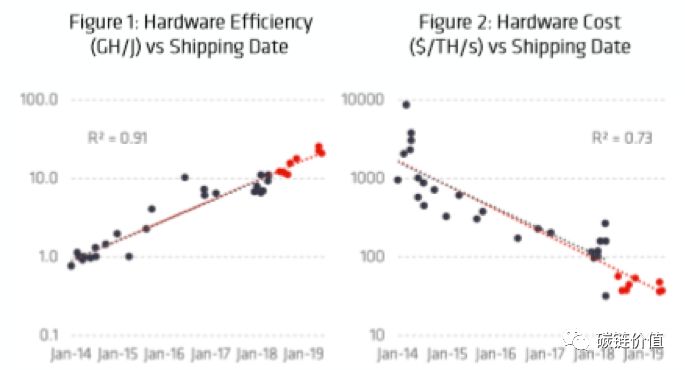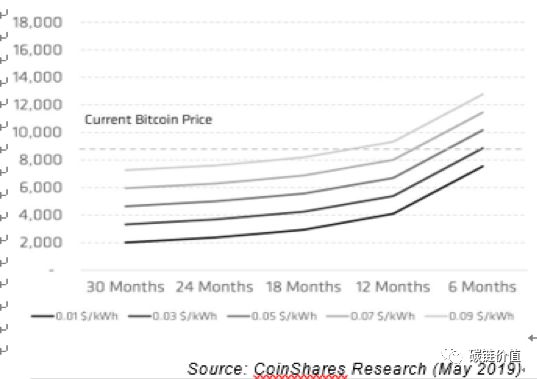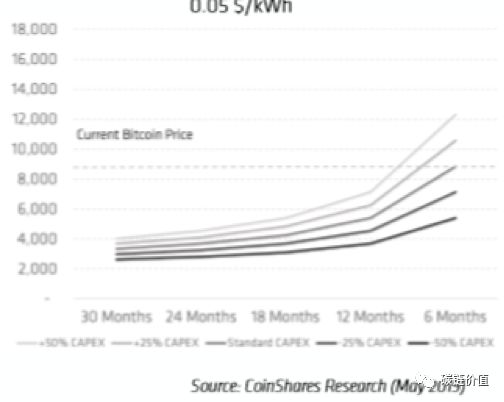Bitcoin Mining In-depth Survey: Chinese mining machine dealers dominate, mining in the first half of the year is called profiteering
This article is "Bitcoin Mining Deep Survey: Is human being wasting energy or creating energy? The companion article of "". Both articles are from an in-depth survey of the Bitcoin mining industry by Coinshares. It is worth noting that although the time of writing this article is in June 2019, it deviates from the current mining status. However, the calculation of mining cost is worth learning and learning.
By reading this article, we can see that even if Bitcoin prices rise to $10,000 (when June 2019), we may mine Bitcoin at a cost of less than $3,500. The time lag between the mining market and the bitcoin secondary market has given the miners great arbitrage. In addition, through the calculation methods provided by Coinshares, we can find a way to price the mine.

There is no doubt that miners are critical to the bitcoin protocol and network health.
- Video | Babbitt "8 Questions" 2 minutes mixed, 40 industry big brothers together with the box, inciting people!
- Bitcoin breaks through 10,000, and the bull market really depends on halving support?
- R3 enters into strategic partnership with Dubai Financial Technology to build the next generation financial architecture for Islamic capital markets
However, due to opacity, the bitcoin mining industry always gives people a sense of mystery, which has caused many misunderstandings. For example, many Bitcoin supporters hope to centralize mining, but so far, the entire mining industry still Towards centralization, the computing power is also concentrated in the hands of some large mines.
So, how can we achieve the ultimate goal of decentralized mining? Quite simply, we need to understand Bitcoin and Bitcoin mining ecosystems first. It is also necessary to fully study the bitcoin mining network, because if there is no extensive research and collection of mining dynamics and economic data, It is difficult to make an accurate judgment on this "mysterious industry."
If you don't say much, let's get to the point.
Overall, although the proportion of fees in the total income of miners has increased, the vast majority of miners' income sources still come from mining incentives rather than handling fees.
According to CoinMarketcap.io, during the 2018 period, Bitcoin miners received a value of $5.5 billion in mining awards, of which $5.2 billion (about 97%) was newly dug by bitcoin and another 300 million. The US dollar (about 3% of the total) is the transaction fee. If you calculate the bitcoin price on May 31, 2019 and the 30-day average cost per block, the annual return of Bitcoin miners is expected to be $6.2 billion/year, 94% of which comes from the newly dug bitcoin. 6% comes from transaction fees.
01 bitcoin network development
In November 2018, the bitcoin network computing power was about 40 EH/s, and in June 2019 it increased to 50EH/s, an increase of 25%. However, the growth rate of bitcoin computing power during this period is lower than the 10-year average (as shown in the following figure), but it is equivalent to the five-year average (calculation starts from 2014, because 2014 is basically an industrial digging The iconic year of the mining era).

In the past half year, we can actually divide the bitcoin market into two phases: a fall stop and a bottoming out. The initial price rebound of Bitcoin seems to have been affected by the flood season in southwestern China. From the current situation, the bitcoin network computing power has completely recovered and broke the highest level in history.
During the transition from bitcoin bear market to bull market, we can observe two substantial macro trends:
1) Many mining entities have gone bankrupt, liquidated, or transferred ownership, and finally the miners who survive in the market are those with sufficient capital stock;
2) The latest generation of mining equipment was first deployed on a large scale.
It is worth noting that the bitcoin computing power dropped by about 40% at the end of 2018, which is the first time that the computing power has decreased due to the continuous large-scale correction of bitcoin prices. However, this situation does not cause Bitcoin mining to fall into a death spiral (that is, the price decline causes some miners to shut down, the power is plummeted, and the safety is reduced, which in turn leads to a decline in the price of the currency). On the contrary, the Bitcoin system is completely in accordance with it. The design is acting, the difficulty of mining is also reduced as the computing power declines, and the decline in bitcoin prices also leads to a reduction in mining costs.
Let us look at the second phase of the first half of the first half of the year, the period of computing power recovery, which is driven by two factors:
1) As the price of Bitcoin rebounds, most of the mining equipment that was previously shut down is restarted, and the cheap electricity price during the wet season also allows the mining machine to obtain positive cash flow;
2) With the arrival of the rainy season, the next generation of mining equipment was promoted on a large scale, mainly in Sichuan. Unit power (TH/s) and dollar costs are also rising, which is roughly in line with the five-year trend (as shown below). Not only that, the improvement of mining efficiency also promotes the current mining efficiency to the highest level of 11.5 GH / J, higher than 10.5 GH / J in November 2018, an increase of more than 10%.

According to current estimates, the depreciation of mining machine ¢ 5 / KWh and 18 months of capital expenditure is about 5,600 US dollars, compared with about 8500 US dollars in November last year. The US/BTC Market-Wide Creation Cost under the assumption of 15% C&O working capital and standard capital expenditure, as shown in the following figure:




The margin of cost creation of electricity operating capital and capital expenditure at 0.05$/Kwh:

03 Average Cash Flow Breakeven Levels (Average Cashflow Breakeven Levels)
Another cost metric to consider is the average cash flow breakeven level, which is critical for estimating price levels, as ordinary miners have to close their mining equipment once they are below the average cash flow breakeven level. Of course, the return on investment level indicator is equally important, but if the price continues to fall below the average cash flow breakeven level, it means that the miners will get less and less money, and as time goes by, it will affect the entire industry. The proportion of ownership, which in turn led to a decline in the overall network computing power.
If estimated by ¢5/kWh and 15% C&O working capital, the current market average cash flow breakeven level is about $3,300, which is higher than the $3,000 in November 2018. The reason why this indicator will improve is that the total network total power has increased by 25%, and the mining efficiency of mainstream mining machines has also increased by about 10%.
04 bitcoin mining power consumption
At the time of this writing, the total electricity consumed by bitcoin mining is estimated to be 4.7 GW, which consists of two parts: one is the electricity consumed by pure mining, and the other is the extra electricity consumed by the mining machine for cooling/cooling. (In 2018, this energy consumption is estimated to account for 20% of the total bitcoin mining capacity, but it is found that this ratio is heavily exaggerated, so the estimated ratio in 2019 is about 10%).
Therefore, if you simply estimate the electricity consumption of bitcoin mining, it is about 4.3GW, which is higher than 3.9GW in November 2018. However, power consumption growth is also reasonable, because the total network computing power has increased by about 25%, and mining efficiency has also increased by about 10%.
It is worth mentioning that, in general, the more electricity consumed by the Bitcoin mining network, the more the electricity market is willing to sell more power to the miners, and the block rewards from miners (including newly dug bitcoins and fees). There will also be a part of the payment to the electricity supplier. However, the mining efficiency of the mining machine has no effect on the total power consumption of the network, it only increases the power per unit of electricity consumption.
From this perspective, the higher the price of Bitcoin will attract more miners to enter the field, and they will have more money to pay the electricity supplier. Therefore, in the long run, the value of block rewards can affect the total power destruction of the entire mining network.
Author: White Night
Editor: Tang Wei
Produced: Carbon chain value (cc-value)
We will continue to update Blocking; if you have any questions or suggestions, please contact us!
Was this article helpful?
93 out of 132 found this helpful
Related articles
- Blockchain security | APT attacks against a blockchain digital cryptocurrency trading platform
- The multiple contradictions are concentrated and the reasons for the low XRP currency price are down?
- 78% of the cottage currency hit a three-month low, is it worth investing?
- QKL123 market analysis | Bitcoin rapid downturn, the altcoin transaction against the new low (0829)
- Institutions sought after, Angel Wheel financing 20 million, what is the advantage of NewStar (net red chain) that changes the underlying accounting logic of the online red industry?
- Bitcoin is the first to adopt bitcoin, and GMO, the largest Internet company in Japan, pays more than 4,700 employees in bitcoin.
- Bitcoin transaction data analysis: US dollar ranked first, Asian market still dominates





